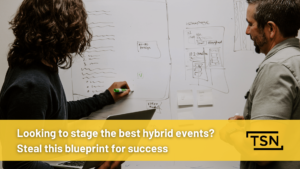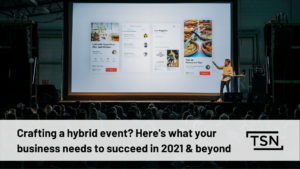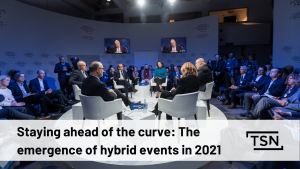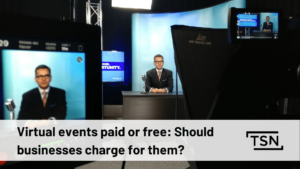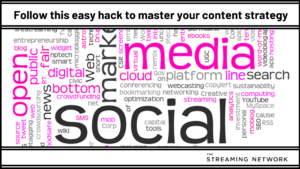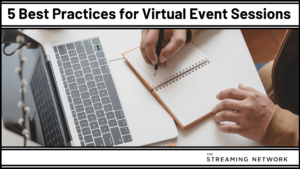Podcast: Play in new window | Download | Embed
Subscribe: Apple Podcasts | Google Podcasts | RSS
Last time, on “The Webinar: Lessons From The Front Line”, we discussed how to identify your best webinar leads, and how to score them.
In the latest episode, we’re going to look deeper into these subjects. We’ll be looking into qualifying your leads, and understanding where they are in your sales pipeline. After all, the end goal is to close the sale.
It’s important to understand your audience in order to understand where they are in your sales pipeline. This way, you can convey the right message, at the right time, to the right people. But, where do you start when it comes to understanding your audience?
Tune in as we discuss the following topics:
- Who is your audience? If we’re going to be digging in, we’re going to have to start at the beginning.
- Understanding the importance of well-thought-out KPIs. Are you going for the ego KPIs?
- What are simple ways TSN qualifies their leads? Be very clear of your steps to your audience—your leads depend on it.
- The importance of bringing 100% of your sign-ups to your webinar. They’re clearly interested. Now it’s time for the push.
The Complete Video Transcript:
Peter Vamos: Welcome to LFTF, the podcast about webinars and tips and tricks to make your webinar programs hum. With me as usual, Matthew Ley, President of The Streaming Network.
Matthew Ley: Peter, how are you?
Peter Vamos: I’m very well, thank you for coming again.
Matthew Ley: No problem.
Peter Vamos: Today– in the last podcast we talked about engagement and how to score leads and understand what leads work. We want to dig into a little bit on this one and do more of a step by step approach. We’ve got people asking us, they want us to get more granule. They want us to dig in on the subjects–
Matthew Ley: –Right–.
Peter Vamos: –So this is the perfect subject to really dig on. So let’s dive right in. When we talked last time about leads–
Matthew Ley: –Yep–.
Peter Vamos: –We really talked about the final, but what are some of the things we really want to talk about when we’re digging in?
Matthew Ley: Well, I think we’ve got to start, with most things, we’re giving somebody a step by step, I start at the beginning.
Peter Vamos: Start at the beginning.
Matthew Ley: I start at the beginning.
Peter Vamos: Always the place to start.
Matthew Ley: And we always got to start with any webinar, whether it’s bigger content or anything that you’re doing, you got to start with who’s your audience. And marketers will get the most out of their program the more targeted they get, and the better they tailor their message to that audience that they’re targeting.
Peter Vamos: Which is something actually that marketers tend to worry about, is it going to limit the number of people, is it going to somehow make their viewership less.
Matthew Ley: Yeah, one hundred percent. And this goes back to one of the KPIs that you’re tracking and are they ego KPIs number of people through, or are they meaningful KPIs like pipeline sales and actual dollars for your organization. I’m not blaming anyone ego KPIs, we all live on them, I live on them too. But it really comes down to how it is that you’re impacting the pipeline for the organization and so the more targeted you are, the better.
Peter Vamos: Right.
Matthew Ley: So here’s an example of something that we do that we learned from others and the like, is we have a financial services practice so it’s a big part of our business. In Canada, they’re a huge part of the Canadian economy. And we service a number of different aspects of it. So when I’m at a conference, like a marketing conference, there’s always a high volume of financial services marketers there. We get the list afterward. One of the things we do is we will invite them to a financial services webinar. Now that webinar is something that we’ve already recorded. So we’re not necessarily doing it again, we’re just taking it and doing a stimuli, but I could very easily deliver it again.
And in that case, my target audience of invitees is very small. It’s 80 to 90, sometimes bigger if there’s a virtual aspect to the conference, of key demographic buyers. And so it will be less people through, but it goes back to that idea if when they go through, they’re the right people.
Peter Vamos: Right.
Matthew Ley: The thing I like about doing this kind of stuff is one of the other worries that we have when we’re doing our– well we even have it too, cause this podcast is part of our broader strategy, right? So that I’ve got a concern in our broader strategy, in our big list, if you will, in our emails, that we’re going to oversaturate with too many messages going out. And when you start getting more granular, more scalpel approach to who you’re targeting in your content within your webinar, then it allows you to not worry about list saturation, because you’re going at a specific group. You attended Conex, Matt was there as a speaker or panelist, you’re in the financial services, just happens we’re doing a webinar on financial services, we would like to invite you to that. And you can apply a– not an aggressive approach, but you can send more emails to those who open versus those who don’t and all of that because you’re not going out to your big list and you can really maximize those leads.
Peter Vamos: Okay. So let’s talk about the event itself.
Matthew Ley: By– before we get there, there’s a bunch of other stuff you can do now, right? So in our organization, we’ve got this list and we’re going out to it, right, and we’re sending out our communications. But we also ensure that the BDR team is aware and aligned with this, and our sales team. So those who are supporting the financial services practice know that there are other prospects that are in their pipeline, who maybe haven’t taken the chance to sit down with them this year, or already or whatever it is. Those are people, we call them the DREP, who should get that note, “Hey, this is something you might be interested in.”
What our BDR team will do is they will scour the non-MQLs, people who have been coming through our pipeline but are not– clearly our marketing agency has determined are not ready to be engaged with. And they’re going to scour and pull and say, “Hey, invite those people to this webinar as well, so we can help grow it.” And what we also do at the time is utilizing look alike audiences on LinkedIn and some of our ads. Not broad-based ads, but just– we put a little bit of an extra push on our posts on LinkedIn and on our social media, as well as target those folks.
So we’re still hosting the webinar, and even if we started with that smaller audience, our invite T-list, we still want to maximize as many people, of the right people, in and through this. And this way we’re able to hit it from multiple sides and maximize that audience.
Peter Vamos: Good, okay. Okay, so, we can talk about the event?
Matthew Ley: Yeah, yeah.
Peter Vamos: Now we can dig into that?
Matthew Ley: Yeah.
Peter Vamos: Okay, so–
Matthew Ley: –Well, sorry. Before the event, you’ve got a couple other times where you get to engage with people, right? So we all know, if you’re here and you want to know this in depth, you all know that not everyone who even registers or says yes shows up, right? We have that 50% number below to the live, and we’ve got to continuously remind people. A reminder that you will be– that you’ve signed up, so please show up, that you were interested, it’s still interesting kind of thing.
And we’ve had great success in picking our primary call to action early, and driving it through this entire process. So when we’re doing a webinar on basically in our case, it’s about stats in the financial services industry, what people should be looking for, what success looks like, and all of that stuff. We have a high-value form which is called the Webinar Report Card.
Peter Vamos: Right.
Matthew Ley: And we basically embed that in our confirmation emails and our reminder email saying, “Looking forward to seeing you, if you want to get your webinar evaluated, or assess the performance of your own webinar program, click here.” And this form, we’ll be talking about it over and over again, but this form lets us know if people are evaluating cause it asks them if they’re looking to improve anything, and it gives us a bunch of very important stats like, number of webinars they’re doing, number of viewers they have, things like that that show fit for us.
It gives them a little bit of value because when they fill it out, we give them a bunch of tips and tricks for getting more viewers and being more engaging and all of the like. But for on our side, it’s once again helping us qualify this lead. And basically anyone who fills that out, it tells me they’re ready to talk to us. In one way or another, they’re ready to talk. So we start the process by embedding it in those confirmation emails, and then we’re ready for–
Peter Vamos: –The event! You’re ready for the event.
Matthew Ley: Right, so…right. So we’re ready for the event. And we’ve got entire webinars on content, so I’m not going to say a lot. But now that we have the event, we want people to engage with us. So if you haven’t read the webinar engagement eBook or listened to our podcast on engagement, just remember, we operate under the premise that people need choice for how they engage with us, don’t just put a question box on it, that your format of your content needs to leave room for the engagement.
And you want to make use of multiple tools, and go into it thinking they’re not going to engage, so you must tell them to, right? Just because there’s a bunch of resources here that people can download on a webinar, doesn’t mean that they’re going to or they know why they should.
Peter Vamos: Right. So you want to get into some specific types–
Matthew Ley: –Tell them why, exactly, tell them why. So let’s talk about resources in general.
Peter Vamos: Sure.
Matthew Ley: So here’s the strategy that we put in, is that I like to keep resources to about three. Sometimes, depending on the type of event, you might want to really bolster it, right, like if you’re doing a big something where you promise a whole bunch of information, you got to give away. But generally, I put three resources in. I put one that is general interest, like a whitepaper, product platform overview, or the PowerPoint deck. That basically tells me nothing, it tells me they’re about as interested as I thought they were cause they were there, right?
And then I put one that shows a little bit of more interest. So there is the– in the financial services one, there is a couple case studies that we put in, a couple different case studies in that one. And those case studies tell me something, they tell me what they’re interested in. So in that webinar, if memory serves me, we have one case study about saving time and money, and we have one case study about demand generation and turning your CE program into a lead generation machine with dynamic funds.
Those two things tell me something very different, but they also tell me that the people are interested in doing better, even if they don’t click on my most important resource, the third resource, which is the high-value form or the Webinar Report Card.
Peter Vamos: Right.
Matthew Ley: Right, so if someone clicks on that, they want to know how to make their webinar program better. They’re ready to talk, hopefully, with us. And I know, even if they don’t fill it all out, not that it takes that long, but people are people. If they clicked on it, that is the lead. That right there is the person that we should be following up with. So strategically positioning those leads, those resources with different values.
And then if you’re integrated into your marketing automation platform or your CRM, then you can assign that and that’s going to really help you in very quickly assessing this or doing it on mass. Integration’s a big part of that, is going to let you again, what we’re looking to do here is to pick out those guys that we think are ready.
Peter Vamos: And in each case, you’re seeing where in the funnel they are, right? If they’re going for that third piece, that’s great. If they’re going for the first piece, then at least you’re giving them a good piece with all the–
Matthew Ley: –That’s it–.
Peter Vamos: Something for everybody.
Matthew Ley: Exactly, something for everybody, and you’re not wasting your time, you’re not wasting theirs kind of methodology and that’s how we test things. We vet by that.
Peter Vamos: But people don’t– I mean it’s hard though, right? It’s hard to actually get people to take actions in a webinar, it’s the great challenge.
Matthew Ley: It so is.
Peter Vamos: Yeah.
Matthew Ley: It so is. And there’s got to be, you have to have a reason for that. So when I’m on your side of the desk, and I’m moderating webinars for Autism Ontario, it’s one of the things that I do, quite often I talk about the resources because we’re dealing with topics that are so massive that we can’t dive in. And we have to give these resources to the audience cause they’re starving for information. Marketing webinars, the audience generally isn’t that starved, right? Like they’re there to be wowed, to learn, to whatever, but it’s not like they’re starved for information. So you have to tell them why, right?
Peter Vamos: In fact it’s probably the opposite, right, I mean–
Matthew Ley: Exactly. They feel like they can get the information anytime they want. They know you’re going to follow up with them. They’re not sitting there going, “I’m never going to hear from this person again, Matt, oh my god, I’m never going to learn about webinars again,” no, they know they can call the company and get a meeting with me, they know they can download stuff everywhere, that’s what we do.
So you have to tell them why. So in the case of the case studies, what I like to do, I like to have it in the content and talk about it. You know, BMO Global Asset Management saved $30,000 in costs in this many hundred man hours while improving this, we talk about that through the idea of automated CE or whatever.
And then, say something like, “We don’t got time to go into that. That’s a whole webinar on its own Pete, but to dig in on that go to the resource section and you’ll see how they save that time and money by x, y, and z.” And so you kind of are prompting them to get there, right? You prompt them to click on the Webinar Report Card–
Peter Vamos: –Right–.
Matthew Ley: –By letting them know that they can assess their webinar program by clicking there, and they can know how they stack up. But if you just hope that everyone does it, then they’re not going to. So you’ve got to keep talking about it.
Peter Vamos: You got to really sort of lay it out for them.
Matthew Ley: Right.
Peter Vamos: Right.
Matthew Ley: And in that case I call it assess your program, not Webinar Report Card, cause that tells them that they’re going to get something out of this experience. And it’s similar to the terminology that we use when we are on any CTA that we use to get people to book a consultation with one of our webinar experts to evaluate their program, it’s the same idea. It’s a consultation, it’s an assessment that we’re giving people.
Peter Vamos: Right. What about other useful interactive features? What other stuff are you employing? I mean those are great–
Matthew Ley: –Yeah–.
Peter Vamos: –Those three are great, but you got to bring more to the table.
Matthew Ley: Yeah, and then, again, especially for those audiences who aren’t quite there yet, right, who aren’t quite ready to take a next step, who have their ideas for buying your product or service way down the line, or weren’t here for that. They were here for the information that you were going to give. And this comes into elements of the platform that have been around forever, are available in every single product, and are used the poorest and the least because people say, people don’t use them.
So the first one is polling.
Peter Vamos: Right.
Matthew Ley: So polling has been around forever, and people say– quite often, we have customers who have been with us for many years, I talk to them in their annual review and they say, “We want to start using polling.” And this is kind of like people in this day and age saying they want to start using their parking brake, if that’s even a thing. Something that’s been around forever, and people should’ve been using, and now they want to learn how to use it, because for whatever reason they thought was too hard. And that’s because they thought of polling as that idea of working it into the presentation in such a way that they ask a question, they wait for responses, they comment on responses, and they ask it back. That doesn’t– not all content lends itself to that style.
But the poll is something that people generally do fill out. It’s right there in front of them. People actually like to click, they don’t like to sit back and just listen. They’ve been forced to do that by a boring format in webinars of lecturing for 45 minutes and then asking if they want questions. So I say ask them questions every two or three slides, questions that help you qualify them as a prospect, questions that help get inside their head, and questions that will help with your story moving forward. So, if it’s how many of something did they do in a course of a year, what are their biggest challenges? How likely are they to buy? Whatever it is, you put those throughout the webinar. You don’t even have to reference them, you just put them up, people will click, and it’ll get you more information and more data.
Surveys as well, a lot of people have abandoned surveys because people don’t fill out surveys, and it’s true.
Peter Vamos: Polls are easier because you’re clicking on a box as opposed to–
Matthew Ley: –Right, yeah–.
Peter Vamos: –Answering something and having to, yeah.
Matthew Ley: Yes, how did you like our content, how good was the speaker, what would you like to… whatever. People don’t have a lot of time in this day and age, we’re in a battle for time constantly. And there are two people that will fill out a survey, they highly, highly engaged person, and the miserable person who had a problem technically or is just a troublemaker. And we get those, right, we have the people in our webinar who show up just to challenge us, right?
Some of the stuff that comes to me, on like my Friday email like a response from someone, and it’s like okay, you disagree. I don’t know why you don’t unsubscribe, but instead, you respond to me and disagree, it’s kind of interesting. But we have those people in all walks of life, and it’s great, and it’s fine.
So my survey now has two questions, and one of those questions are, what other topics would you like us to cover, which no one’s going to be compelled to fill out, but sometimes both of those two people will. And the next question is basically, will you be evaluating in the next year, or how likely are you to evaluate our platform in the next 90 days, something like that, that is very similar to taking action but it’s kind of like a step below.
In every case, in all of these interactive, afterwards we look at them and we see where everyone lies, A, B, C. A goes to sales, B goes to BDRs for a follow up, and C stays in the marketing trip, that’s it, because we want our guys focused on those deals that are the best, so.
Peter Vamos: Good.
Matthew Ley: And finally, I know I’m rambling on this one, but I will, is make sure that you’re clear on the steps, the various next steps, and you can give people choice. So we recently launched a part of the platform which is called the CTA Widget. And what it is does is at the end of the webinar when it’s done, usually it says “Thank you for attending,” and everyone goes home.
We give people three options, two or three options. One, contact sales right now, two, sign up for this, watch this next webinar which is the next stage in the evolution of the process. And three is whatever it is, probably in our case do the webinar assessment or the Webinar Report Card. So if they’ve come to the webinar and they haven’t done it yet, we give them the same option they’ve always been given.
We give them a direct option, and then we give them an option to self-educate some more. And that’s because we recognize within this webinar itself that our primary goals to get the most engaged and most ready people to our sales team. And if they’re not quite ready, they didn’t hear enough, that we keep them in our– we get them moving through our pipeline by evaluating more content.
And it’s nuts that we have to do it in our follow up emails at the start, we have to do it three different places within it, and then at the end as well, because people made that decision to take that next step at different points in the conversation and so you need to be consistently be putting those opportunities or those options in front of them.
Peter Vamos: Right, and some people may not engage with something but if you’ve asked them, talked to them, that’s gold, right, if they say, “I’m in.”
Matthew Ley: That’s it. There’s an old case study, QASymphony where started thinking of this idea of just ask, where they basically said to cut out the guessing game, they’re just going to ask people at the end of the webinar, “You ready? Click here and we’ll have someone follow up and book a meeting.”
Peter Vamos: Yeah.
Matthew Ley: And that’s it, and that was it, click here, it was yes/no. It wasn’t any of this other stuff, it was yes/no, we want to go to demo. So sometimes it can be just that simple.
Peter Vamos: Just that simple, great. Okay so the webinar is done–
Matthew Ley: –Yup–.
Peter Vamos: –But that’s not the end, obviously.
Matthew Ley: Yeah.
Peter Vamos: So what happens now, so after the webinar what are the next steps?
Matthew Ley: Thank you for attending, sorry we missed you. But the thank you for attending is for all those people who showed up, and you basically, once again, you want to prompt them to take that action and whatever that is. So we once again, we embed the Webinar Report Card in it. Sorry we missed you, it’s just one step though.
I mean you work pretty hard to get, say, 250 registrants, you got whatever you got to show up to it. You remember, we had BDRs, we had ad campaigns, we paid to be at a conference to get these people in the first place. Keep promoting that on-demand or simulate a live, try to get 100% of those people that were there, that said yes initially to register, to at least view the on-demand. A lot of us forget about it, we send one email and we walk away. These people had an interest–
Peter Vamos: –Right–.
Matthew Ley: –I’m not saying everybody that was on that list. I’m saying, push those people who said yes and registered. So generally speaking at the end, we get the thank you for attending and sorry we missed you out, the system does that automatically. There’s not a ton of– I don’t know, there’s not a ton of work that goes into those, there in the system we have a template.
But then we go out and we go back to the initial list and we let them know that they missed an awesome, amazing webinar. And we have a couple of emails that go out to those people who registered but did not attend, trying to prompt them to get into the on-demand. So we want to maximize all the time and effort and promotions, that we put together to get people in.
Peter Vamos: Right, so what does success look like? And when you’ve done all this stuff, what are you looking for, what were the KPIs?
Matthew Ley: So I know that we’re reaching the end of time, cause I did a sneak peek myself so I’m going to be high level and I think we’re going to have to dive into this a little bit more next time, right? So your goal should always be to know your KPIs, and your KPIs are going to constantly change based around the promotion that you are doing. Our broad-based thought leadership, 6000 invitees are targeted financial services, 60, 70, 80 invitees, we’re going to have different goals for it.
But you want to start knowing your invites– when you’re doing the targeted ones, you got to understand what your targeted invites to viewers are, and you want to be measuring both live and on-demand when you do that. You want to then understand how many of those viewers took the action you wanted them to take, and which of those actions. So usually that’s an SQL MQL thing, yes I want a meeting with sales, MQL take the next step, watch the next webinar, watch the next video. From there, get with your VP of sales and start tracking what pipeline was created, and then measuring long term what the dollars were.
So now once you’ve got that done, now you know what are the number of targeted invitees I need to find for any given webinar, or in the course of the year for it. And these targeted, scalpel approach webinars that are focused on business sectors or types of buyers or whatever it might be, they’re harder to get huge numbers out to you, but they are actually much easier to get to those real KPIs. So success, Pete, looks different for every webinar and every person, but the hope should be to segregate these two ideas in your head of thought leadership, big new leads, to moving people through with these types of webinars, and your KPIs in both cases are different.
Peter Vamos: Right, right. But you’ve got to– you have to know what they are and you have to be going after those things–
Matthew Ley: –Yeah, and nine times out of 10 I sit down in rooms and I ask the question, and we’re starting to get to a point where people have certain KPIs that really matter, or they understand them, but for the most part they don’t.
Peter Vamos: Right.
Matthew Ley: And so, that sort of process is where you need to start. And I assure you, that even if you don’t get to the end of KPIs by doing this process, those targeted approach webinars are going to get you way more qualified leads, bigger pipeline, and bigger revenue impact for the organization that might allow you to hire that person or buy that software that allows you to do the actual KPI targeting you want to do.
Peter Vamos: Right. Well, that is another episode. Matthew Ley, thank you very much. It would be great to hear from– this is really good in-depth stuff around webinars. Hopefully, we’re providing great insights, I know I’m getting good insights.
Matthew Ley: Yep.
Peter Vamos: Anybody in the audience has questions, shoot them our way. Don’t forget to share, sharing is very important for these sorts of things. Sharing is caring–
Matthew Ley: –Sharing is caring–.
Peter Vamos: –As they like to say. So until next time, we’ll see you again.

